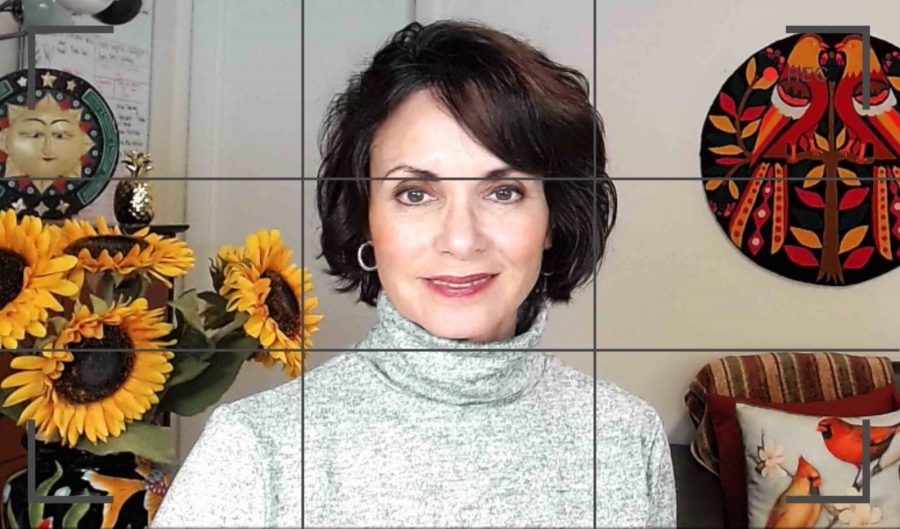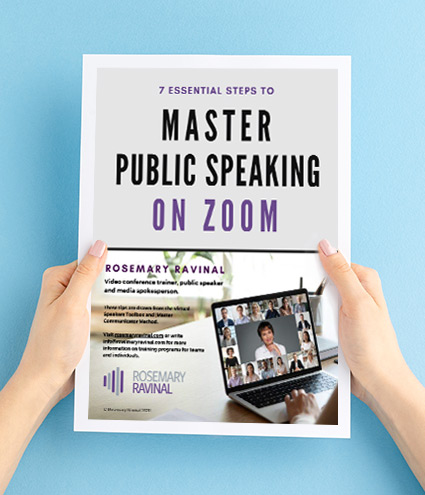The rule of thirds describes a basic compositional structure of a photograph. You take an image and split it into nine segments by drawing two vertical and two horizontal lines. When filming or photographing people, it is common to line the body up to a vertical line and the eyes to the top horizontal line. While there are other forms of composition, the rule of thirds generally leads to a pleasing and well-composed portrait.
Professional photographers reading this may cringe because the 3×3 squares grid pattern is more of an artistic guardrail to create compelling compositions where the subject will likely be off-center.
But for purposes of understanding how to position yourself in the Zoom rectangle, the rule of thirds can be a practical tool to compose your shot. The 3×3 grid can be found in the settings of most cameras, some webcams, and smartphones. If you don’t have it or can’t find it, imagine dividing your image on the screen into nine equal zones using horizontal and vertical lines.
Why does it matter? Because how you are framed in the shot affects how you are perceived.
I conduct frequent group and individual public speaking coaching sessions on Zoom and observe how often people unwittingly give up their poise and presence because they don’t know how to set up their shots.
Last week, I attended a Zoom meeting where half of the participants were either cut off at the neck or looming over the camera like a colossus. (Don’t get me started on their choices of virtual backgrounds.)
According to Rachel Cossar, co-founder and CEO of Virtual Sapiens, you cannot discount the importance of framing and posture in the virtual world. Virtual Sapiens is the developer of Sidekick, the app that uses AI to analyze what your body language is saying during video calls. “If your framing is off, your posture is likely to be as well,” she said.
Sidekick picks up framing and posture mistakes and provides a performance metric for the user. These two elements correlate directly to your body language, which is integral to your being heard, believed, and understood on video.
“Video is the only digital means of communicating a full message, one which includes the nuance of our tone and our body language. Don’t do yourself a disservice and silence a core part of your impact as a communicator,” Cossar advises.
Let’s take a close look at what this means.
If your camera lens is in the wrong position, you will look awkward because when video meetings are done well, the visual and auditory elements should approximate real life. For example, how would you feel if you are in a face-to-face meeting with someone who is sitting all the time while you are standing? You might feel disrespected or think that the other person is disinterested and can’t be bothered to look at you at eye level. Bad framing can have a similar effect.
If you are framed small on the screen you will appear small. Are you hiding? Do you dislike video calls so much that you would rather cower at the bottom of the frame than show your upper body so you can use your arms and hands to gesture? Hand movements can enhance comprehension of your message by more than 60 percent.
The way you set up your shot sends a strong message to your audience. Virtual executive presence relies on the five ASSETs™ that only you can bring to the online conversation. These are your overall Appearance, the Staging and Styling of your shot, the Energy you project with your verbal and non-verbal communication, and basic competence with the video conferencing Technology of your choice.
Sit up straight in your chair. Use a lumbar pillow for comfort and support. Erect posture will help you breathe, speak more clearly, and stay energetic and alert. Overall, you will look more professional.
Are you towering over your laptop and looking down at the lens? It’s time you understand that the webcam needs to meet your eyes at a 90-degree angle. In other words, at eyeball level. You can use a stack of books to lift the laptop to the correct height or adjust the position of your webcam with a Plexicam clear acrylic mount that attaches to the front of your screen.

10 STEPS TO SITUATE YOURSELF IN THE 3X3 GRID.
Here are ten steps to situate yourself in the 3×3 grid:
- Fire up the webcam before you start the video call.
2. Calibrate your lighting (even and diffused on your face with no shadows).
3. Check your appearance for any unwanted distractions like hair frizz or a piece of arugula between your teeth.
4. Adjust your seat so you are centered in the frame and at the proper eye level.
5. Sit at an arm’s length distance or 25 inches from the webcam.
6. Leave a hand’s-width distance between the top of your head and the upper edge of the frame.
7. Keep a straight posture throughout the call while sitting. The same applies if you use a standing desk.
8. Become more self-aware of how you appear on the screen.
9. Be mindful of when and how you use your hands and head nods to punctuate your words.
10. Stay engaged with your audience by keeping your gaze on the lens and periodically scanning the screen for reactions.
How you show up on video calls can make or break your career, your business, and your reputation. Video conferencing will remain a centerpiece of the new world of work—hybrid, remote, WFH and co-located teams in smart offices. It’s time to up-level your ability to communicate authentically and confidently on the small screen. Get on the 3×3 grid correctly and improve your virtual executive presence.
Video conferencing is the #1 skill you need to succeed in the digital workplace. To that end, I have created ZoomScore™ which will open your eyes to the visual cues that matter most in virtual communications. Take my ZoomScore™ quiz and see how you rate against the 10 most important elements of a professional video shot.






